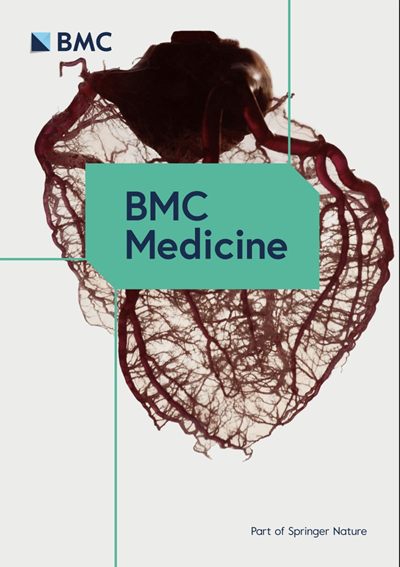Potential deprescribing indications for antidepressants between 2012 and 2019: repeated cross-sectional analysis in two Scottish health boards
IF 8.3
1区 医学
Q1 MEDICINE, GENERAL & INTERNAL
引用次数: 0
Abstract
Antidepressants have a pivotal role in the treatment of many psychiatric disorders, but there are concerns about long-term use and adverse effects. The objectives of this study were (1) to examine time trends in antidepressant use, (2) to estimate the prevalence of long-term and potential high-risk antidepressant use, and (3) to examine patient characteristics associated with potential deprescribing indications (PDIs) (i.e., simultaneous long-term and potential high-risk antidepressant use). Repeated population-based cross-sectional study for all 609,299 people aged ≥ 18 years resident in the Tayside or Fife regions of Scotland. The prevalence of antidepressant use was examined on June 30th (index date) of each year from 2012 to 2019, while the prevalence of long-term and potential high-risk use as well as PDIs was assessed and compared on the same dates in 2012 and 2019. Binary logistic regression modeling was used to examine patient characteristics associated with PDIs. Antidepressant use increased by 27% from 12.0 to 15.3% among adult residents between 2012 and 2019. While the proportion of antidepressants users dispensed ≥ 1 antidepressant for > 2 years increased from 54.3 to 61.9% between 2012 and 2019, the proportion of antidepressant users triggering ≥ 1 indicator of potential high-risk use decreased slightly from 37.9 to 34.7%. In 2019, potential high-risk use most commonly related to indicators targeting fall risk (16.0%), cardiovascular risks (14.1%), insomnia (10.6%), and risk of orthostatic hypotension (8.6%). More than 1 in 4 (25.8%) antidepressant users had PDIs. The main risk factors associated with PDIs included increasing age (65–79, adjusted OR 14.12; 95% CI, 13.15–15.17), increasing number of drugs taken concomitantly (≥ 15 drugs, adjusted OR 7.37; 95% CI, 6.71–8.10), use of tricyclic antidepressants (≥ 50 mg) (adjusted OR 5.49; 95% CI, 5.02–6.01), and concomitant use of ≥ 2 antidepressants (adjusted OR 5.52; 95% CI, 5.20–5.85). Long-term and potential high-risk use of antidepressants is widespread, and potential deprescribing indications (PDIs) are increasing, suggesting the need for a critical review of their ongoing use by clinicians. If deemed necessary, future deprescribing interventions may use the criteria applied here for identification of patients with PDIs and for evaluating intervention effectiveness.2012 年至 2019 年抗抑郁药的潜在去处方化适应症:苏格兰两个卫生局的重复横断面分析
抗抑郁药在许多精神疾病的治疗中起着举足轻重的作用,但长期使用和不良反应也令人担忧。本研究的目标是:(1)研究抗抑郁药使用的时间趋势;(2)估计长期使用和潜在高风险使用抗抑郁药的流行率;(3)研究与潜在停药适应症(PDI)(即同时长期使用和潜在高风险使用抗抑郁药)相关的患者特征。对居住在苏格兰泰赛德或法夫斯地区的所有 609,299 名年龄≥ 18 岁的居民进行了基于人口的横断面重复研究。从 2012 年到 2019 年,每年 6 月 30 日(指数日)对抗抑郁药物的使用率进行调查,同时在 2012 年和 2019 年的同一日期对长期和潜在高风险使用以及 PDI 的使用率进行评估和比较。二元逻辑回归模型用于研究与 PDIs 相关的患者特征。2012 年至 2019 年间,成年居民中抗抑郁药物的使用率从 12.0% 增加到 15.3%,增幅达 27%。在 2012 年至 2019 年期间,配药时间大于 2 年且≥1 种抗抑郁药的抗抑郁药使用者比例从 54.3% 上升至 61.9%,而触发≥1 个潜在高风险使用指标的抗抑郁药使用者比例从 37.9% 小幅下降至 34.7%。在2019年,潜在高风险使用最常见的是针对跌倒风险(16.0%)、心血管风险(14.1%)、失眠(10.6%)和正性低血压风险(8.6%)的指标。超过四分之一(25.8%)的抗抑郁药物使用者患有 PDI。与 PDIs 相关的主要风险因素包括年龄增加(65-79 岁,调整 OR 为 14.12;95% CI 为 13.15-15.17)、同时服用药物的数量增加(≥ 15 种药物,调整 OR 为 7.37;95% CI,6.71-8.10)、使用三环类抗抑郁药(≥ 50 毫克)(调整 OR 5.49;95% CI,5.02-6.01)、同时使用≥ 2 种抗抑郁药(调整 OR 5.52;95% CI,5.20-5.85)。抗抑郁药的长期使用和潜在的高风险使用非常普遍,潜在的停药适应症(PDI)也在不断增加,这表明临床医生有必要对抗抑郁药的持续使用进行严格审查。如果认为有必要,未来的去处方化干预措施可采用本文所采用的标准来识别潜在去处方化适应症患者并评估干预效果。
本文章由计算机程序翻译,如有差异,请以英文原文为准。
求助全文
约1分钟内获得全文
求助全文
来源期刊

BMC Medicine
医学-医学:内科
CiteScore
13.10
自引率
1.10%
发文量
435
审稿时长
4-8 weeks
期刊介绍:
BMC Medicine is an open access, transparent peer-reviewed general medical journal. It is the flagship journal of the BMC series and publishes outstanding and influential research in various areas including clinical practice, translational medicine, medical and health advances, public health, global health, policy, and general topics of interest to the biomedical and sociomedical professional communities. In addition to research articles, the journal also publishes stimulating debates, reviews, unique forum articles, and concise tutorials. All articles published in BMC Medicine are included in various databases such as Biological Abstracts, BIOSIS, CAS, Citebase, Current contents, DOAJ, Embase, MEDLINE, PubMed, Science Citation Index Expanded, OAIster, SCImago, Scopus, SOCOLAR, and Zetoc.
 求助内容:
求助内容: 应助结果提醒方式:
应助结果提醒方式:


